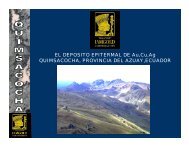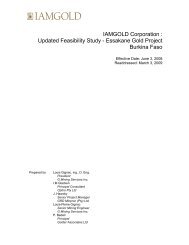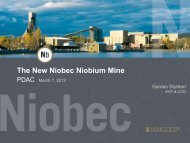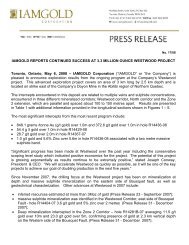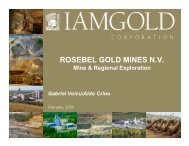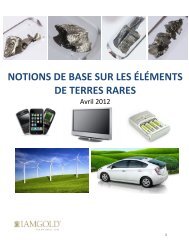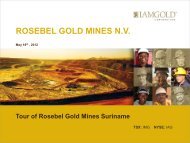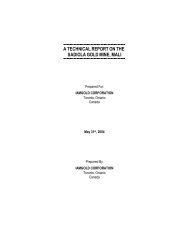NI 43-101 Technical report, Surface diamond drilling ... - Iamgold
NI 43-101 Technical report, Surface diamond drilling ... - Iamgold
NI 43-101 Technical report, Surface diamond drilling ... - Iamgold
You also want an ePaper? Increase the reach of your titles
YUMPU automatically turns print PDFs into web optimized ePapers that Google loves.
R a r e E a r t h E l e m e n t E x p l o r a t i o n P r o g r a m M a r c h - 2 0 1 3<br />
W i n t e r - S u m m e r 2 0 1 2 P a g e | 68<br />
Item 14. SAMPLING METHOD AND APPROACH<br />
For the exploration purpose, sampling for rare earth elements mineralization is limited to<br />
<strong>diamond</strong> drill core. The complete core logging and core sampling method are described<br />
below. Detailed description of the drill core is carried out by experienced and qualified<br />
personnel under the supervision of Louis Grenier and Jean-Francois Tremblay, members<br />
in good standing of the Ordre des Géologues du Québec.<br />
14.1 CORE LOGGING<br />
The core was described by the IOS geologist using the mine geological facies<br />
nomenclature, which is based on Soquem modified facies definition (C1, C2, C3, etc.).<br />
Description includes the alteration types, the major structures appearance, a visual<br />
quantification of the key minerals abundance (Lanthanides, apatite, etc…) and the others<br />
minerals associated the mineralization (magnetite, hematite, chlorite-biotite, pyrite,<br />
ankerite, barite, fluorite and sphalerite). Rock Quality Designation (RQD) is<br />
systematically measured. All the core boxes are photographed and additional detail<br />
photos are taken at a smaller scale when necessary. Since the core is slightly radioactive,<br />
a BGO-SPEC SUPER RS-230 device from Radiation Solutions Inc. was used to measure<br />
the core radiometry. The radiometric readings are giving in Gy/hr and µSv / hr.<br />
Following the 2012 P.-J. Lafleur recommendation, the core was sampled on a nominal 3<br />
metres interval (Figure 20). To respect the geological setting, the samples can be shorter<br />
or longer. The logger records the sampling intervals (from, to) in the log. A rock code<br />
based on the lithology and mineralogy is assigned to each interval. This rock code has an<br />
influence in the resource estimation.<br />
Figure 20: Sample lenght distribution, REE project.<br />
Finally, the hole number, collar coordinates, azimuth, dip, final depth, down-hole survey<br />
data, facies description, radiometry core measures and assays (once they have been<br />
3400, chemin du Columbium, St-Honoré-de-Chicoutimi, QC G0V 1L0 Canada – tel. : 418 673-4694 Fax : 418 673-3179<br />
E-mail : info.niobec@iamgold.com www.niobec.com



